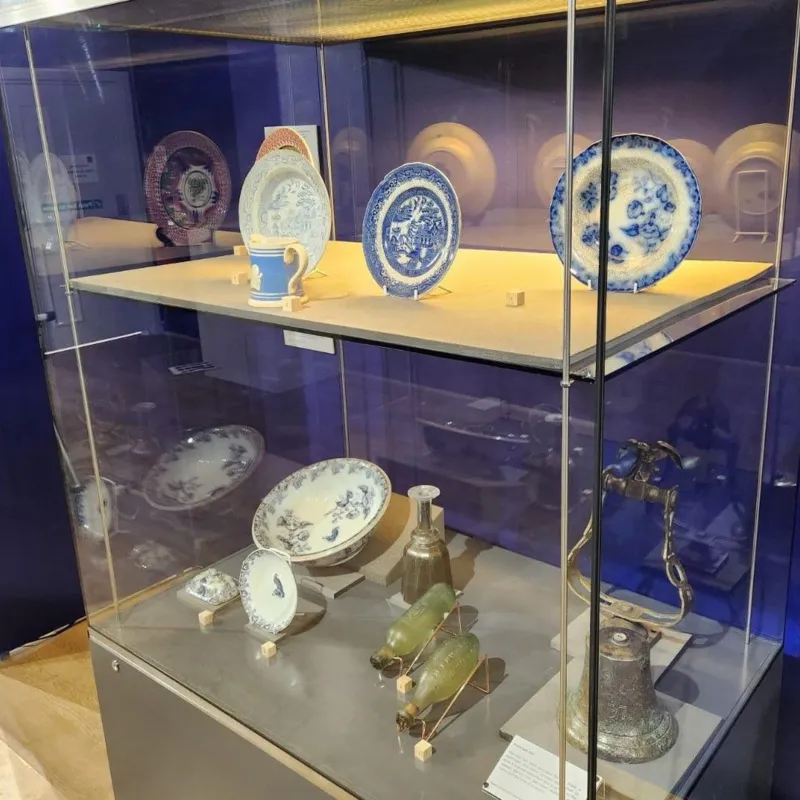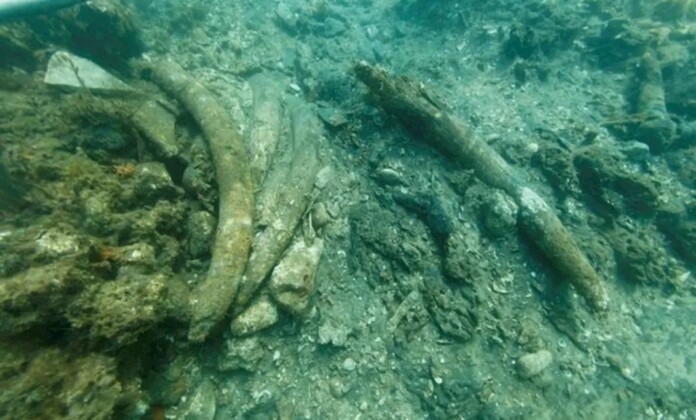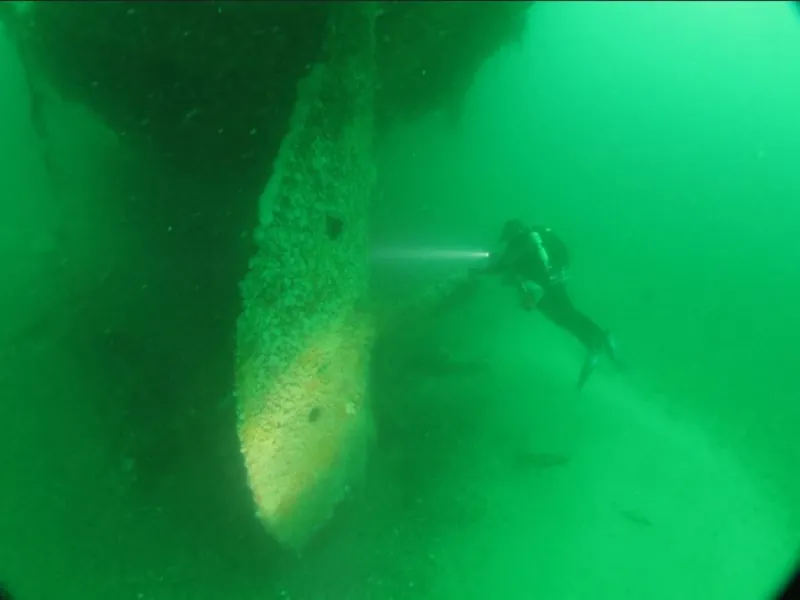HOT NEWS !
Stay informed on the old and most recent significant or spectacular
nautical news and shipwreck discoveries

-
Shipwreck mystery solved after nearly 140 years
- On 07/06/2025
- In Wreck Diving

By Chris Ellis - BBC
The mystery of a maritime disaster has been solved after experts found a vessel that sank almost 140 years ago. Diver and explorer Dom Robinson identified the SS Nantes, off Plymouth, after examining the wreck site and finding crockery.Dr Harry Bennett, an expert in maritime history, said the dive team had found "the underwater archaeological equivalent of a needle in a haystack". Mr Robinson said solving the mystery ensured those who died were not forgotten.
In November 1888, the SS Nantes, which was operated by the Cunard Steamship Company, collided with a German sailing vessel, the Theodor Ruger, said Dr Bennett. The crew spent "several hours" trying to save their ship, the honorary associate professor in history at the University of Plymouth said.
"They used mattresses to plug the gap which had opened up in the hull of the SS Nantes," he said. "[The ship sank] with the loss of a substantial number of the crew. There were some 23-odd fatalities. There were three survivors.
" Bodies from the wreckage washed ashore at Talland Bay and Looe, in Cornwall, and "locals were confronted by this picture of horror, pieces of ship together with bodies," he said.
Afterwards the "wreck was essentially lost, obviously you're dealing in a period with no satellite navigation," said Dr Bennett. He added while the crew tried to save the ship it "drifted for several hours, before it finally made its way to the bottom, sadly, with many of its crewmen on board".
He said the wreck was lost until a local dive team identified it in 2024. Mr Robinson, who has been diving for about 35 years, said he heard about the unidentified wreck from the UK Hydrographic Office.
-
Public to see Arran shipwreck pottery for first time
- On 06/06/2025
- In Museum News

From BBC
Pieces of rare 19th Century pottery - which were recovered from a shipwreck off the coast of Arran - are to go on display for the first time. The ceramics were discovered by diver Graeme Bruce, 65, from Oban in the wreck of the SS Eagle, a mile from Lamlash Bay, last July.The ship - an early steamboat - was heading to Ireland when it sank in 1859 after colliding with another vessel. Eleven people died. Several artefacts made by the Glasgow-based Bell's Pottery will appear in the Scottish Maritime Museum's Summer exhibition which opens in Irvine on Saturday.
Graeme, a retired engineer, and the team of seven other divers, were 53 metres beneath the surface when they spotted the treasure trove of rare pottery. Most of the ship had rusted away but the cargo was lying well preserved in the mud. In the 19th century, Glasgow was a major centre for the production of ceramics and rivalled the Staffordshire potteries.
Bell's Pottery is recognised as arguably the most internationally significant producer of ceramic wares in Scotland at the time. The haul on the SS Eagle is an unprecedented example of an almost intact cargo of 19th century Glaswegian ceramics.
The SS Eagle's ceramics cargo was destined for trade and exhibition in Londonderry. Exhibits include seven plates and a bowl, a teapot lid and two bottles which still hold 'sparkling water' in addition to a decanter and bell. Eva Bukowska, exhibitions and events officer at the Scottish Maritime Museum, said: "We are really excited to host the first showing of these fascinating ceramics recovered from SS Eagle.
"The vessel also has a significance for the museum as it was built by Alexander Denny, who was the brother of William Denny, whose test tank is now home to our second collection in Dumbarton."
-
Dutch shipwreck discovered off Australian coast
- On 17/05/2025
- In Underwater Archeology

By Kameryn Griesser - CNN
Beneath the rough waters of South Australia’s coast, marine archaeologists say they have discovered the lost Dutch merchant vessel Koning Willem de Tweede, which sank nearly 170 years ago.
The wreck captures a tragic moment in maritime history during the 19th century Australian gold rushes. The 800-ton sailing ship was beginning its journey back to the Netherlands in June 1857 when a severe storm capsized the vessel near the port town of Robe, according to a news release by the Australian National Maritime Museum.
Two-thirds of the crew drowned. Just days before, 400 Chinese migrants headed for gold mines in Victoria disembarked from the ship. The crew transported the laborers as a “side hustle” for extra money, according to James Hunter, the museum’s acting manager of maritime archaeology. The practice was a common but questionably legal voyage at the time, he said.
While the captain lived to tell the tale and litigate his losses, the bodies of his crew members remain lost in the sand dunes of Long Beach.
However, on March 10, after three years of searching for the site of the wreck, a team of divers supported by the Dutch Ministry of Foreign Affairs and the Netherlands’ Cultural Heritage Agency spotted what they say is the sunken vessel.
“There’s always a little bit of luck in what we do,” said Hunter, who was the first diver to see the ship underwater. “The sand had just uncovered just a little bit of that shipwreck so that we could see it and actually put our hand on it and say ‘we’ve finally got it.’”
-
Madness, murder and rape on the Batavia
- On 06/05/2025
- In Famous Wrecks

By Tory Shepherd - The Guardian
An “evil” man took advantage of a shipwreck to lead a mutiny that caused the death of more than 100 men, women and children.So goes the story of the Batavia, wrecked off the Western Australian coast in 1629. Survivors of the wreck found themselves marooned on a reef and chain of islands about 60km out to sea. Far from help, in the “harsh and unforgiving end of the earth”, the murders and rapes started.
“More than 100 people died in the grounding but the carnage didn’t end there,” is how the Australian National Maritime Museum describes it.
“What befell the survivors was sheer horror – anarchy, tyranny, madness, murder and rape, in a reign of terror where people were picked off one-by-one.
“Only about a third of the 340 passengers and crew would live.” It’s one of Australia’s most horrifying incidents. Researchers are still studying the mass graves found on the islands.
While no one doubts the terror that unfolded, a Dutch academic has posed a different theory: that rather than a dastardly plot, ordinary men were driven to terrible acts by starvation.
It has been said the Batavia story parallels the TV show Yellowjackets, and it has also been credited with inspiring hit UK reality show The Traitors – which was originally going to be called The Mutineers.
But what if we’ve got it all wrong? The cultural psychologist Jaco Koehler says there’s an alternative scenario that provides “a better explanation for what happened”.
His theory – The Batavia Disaster: A new scenario to explain the massacre after the shipwreck – has been published in the May edition of the International Journal of Maritime History. Koehler writes that bias in the reports from the time and the use of torture akin to waterboarding cast doubt on the theory that one man plotted a mutiny and oversaw a massacre.
-
The true identity of Costa Rica shipwrecks
- On 05/05/2025
- In Underwater Archeology

By Amarachi Orie - CNN Sciences
Marine archaeologists have discovered that two shipwrecks in Costa Rica are the remains of Danish slave ships missing for centuries — a finding that restores the ancestral lineage of an entire Costa Rican community more than 300 years after the vessels’ occupants reached its shores.The wrecks had long been known to sit in shallow waters off Cahuita National Park, on Costa Rica’s southern Caribbean coast, according to the National Museum of Denmark. However, for years, they were believed to be pirate ships, the museum said in a news release.
Fisherpeople who established themselves in the area in 1826 thought this because the ships’ remains were dispersed and broken. They believed the two ships might have been engaged in a fight and capsized, Maria Suarez Toro, founder of the local community initiative Ambassadors of the Sea Community Diving Center, told CNN Friday.
The ships’ identities were only called into question in 2015, when American marine archaeologists found yellow bricks in one of the wrecks.
This discovery was significant because yellow bricks were produced in the German town of Flensburg in the 18th and 19th centuries for use in Denmark and its colonies. They were not in fashion in other European countries at the time, according to the museum.
Historical sources had recorded that two Danish slave vessels were shipwrecked off the coast of Central America in 1710: The Fridericus Quartus was set on fire, while the anchor rope of the Christianus Quintus was cut and the ship was swept away.
But the location of the wrecks was not known — until now.
Marine archaeologists from the National Museum and Denmark’s Viking Ship Museum carried out an underwater excavation of the Costa Rica wrecks in 2023, taking wood from one, as well as samples of bricks, and finding several clay pipes.
Researchers at the National Museum and the University of Southern Denmark then carried out scientific analyses that confirmed the historical accounts, the museum noted.
Tree-ring dating revealed that oak wood from one of the wrecks originated from the western part of the Baltic Sea, which encompasses Denmark, northeastern Germany and southern Sweden. The wood was from a tree cut down between 1690 and 1695, according to the museum.
-
Vasco da Gama’s final voyage shipwreck ?
- On 25/01/2025
- In Underwater Archeology

By Andy Corbley - Good News NetworkNot far off the Kenyan coast, maritime archaeologists believe they have found the wreckage of a galleon belonging to Vasco da Gama, the Portuguese navigator who found the route to India around Africa.
While the true provenance of the vessel is unclear, the discovery would be of monumental importance to the study of maritime archaeology, and the history of European exploration.
It was originally identified near the city of Malindi in 2013 by Caesar Bita, an underwater archaeologist at the National Museums of Kenya who received a tip from a local fisherman.
Commissioned in 1497 to find a route to “the Indies,” da Gama was the first European to round the Cape of Good Hope, before proceeding to sail north along the coast of Zanzibar to reach India. It was the first route to India by sea, and it changed European and world civilization forever.
On his third, multi-ship voyage in 1524, one of the Portuguese galleons, the São Jorge, sank somewhere off East Africa, but da Gama died of an illness en route, and a precise location for the ship was never provided.
After years of documentation, Bita invited the Portuguese nautical archaeologist Filipe Castro from the Center for Functional Ecology at the University of Coimbra to investigate the wreck.
-
Hidden treasures: 250 shipwrecks lie unprotected
- On 01/01/2025
- In People or Company of Interest

By Anna Ellis - Euro Weekly News
Alexandre Monteiro, an underwater archaeologist and researcher at Nova University in Lisbon, has identified 8,620 shipwrecks scattered along the coasts of mainland Portugal, the Azores, and Madeira. His findings are based on a detailed database of shipwrecks dating back to the 1500s, compiled from historical records.Monteiro’s research documents around 7,500 wrecks along the mainland coast, 1,000 near the Azores, and 120 in the waters around Madeira. Among these, he estimates that about 250 may hold significant treasures.
One example is the Nossa Senhora do Rosário, a Spanish shipwreck from 1589 located off the coast of Troia. Monteiro explained that his investigation uncovered detailed information about the ship, including its cargo of 22 tonnes of gold and silver and even the name of the captain’s mother.
-
Search for fish prompted 37-year shipwreck quest
- On 01/01/2025
- In Wreck Diving

By Catherine Nicoll - BBCA hunt for better fishing grounds led a man to spend over three decades documenting more than 2,000 shipwrecks in the Irish Sea.
Adrian Corkill's interest in finding vessels lost in the waters around the Isle of Man was sparked in 1987 when he started fishing in a boat on a wreck off Laxey in his spare time.
Curious about the ship on the seabed below, he began researching its story, and went on to uncover 150 other wrecks. Having complied a database of more than 2,000 wrecks, nearly 2,000 wreck sites, and about 1,100 vessels, the 58-year-old transferred the information to Manx National Heritage for safekeeping.
Looking back on his 37-year hobby, Mr Corkill said his interest was initially "fish-orientated".
"I thought the wrecks are good places for fishing, and if you can find more wrecks then you can get more fish." But as time went on his interest intensified, and culminated with him learning to dive to broaden the range of wrecks that could be reached.
While a ship's bell was the most straightforward way of identifying a vessel, finding it was not always that simple. "It's a detective story. Sometimes you're lucky and you get the bell straightaway, and that's job done.
"Other times you can dive a wreck repeatedly and still not find the bell. "It's probably covered in debris, because a lot of the wrecks are quite collapsed.
"If a bell falls within the wreckage it can be buried underneath metal or sand, so it will be there somewhere.